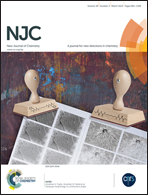Gold(iii) complexes of 5-methyl-5-(pyridyl)-2,4-imidazolidenedione: synthesis, physicochemical, theoretical, antibacterial, and cytotoxicity investigation†
Abstract
This work reports the synthesis and characterization of cytotoxic gold(III) complexes of a series of 5-methyl-5-(pyridyl)-2,4-imidazolidenedione ligands. Based on the elemental analysis and inductively coupled plasma-mass spectrometry (ICP-MS), the complexes have the general formula AuL1Cl2 (1), [Au(L2)2Cl2][AuCl4] (2), and [Au(L3)2Cl2][AuCl4] (3) (L1, L2, and L3 = 5-methyl-5-(2,3, and 4-pyridyl)-2,4-imidazolidenedione, respectively). All the compounds were studied by means of IR, 1H, 13C NMR spectral analyses, molar conductivity, cyclic voltammetry, and DFT methods. The studies showed the complexes have square planar geometry, common for d8 complexes, with the ligand molecule coordinated in an N-coordination bidentate (1) and monodentate (2 and 3) fashion to the metal center. DFT studies on different geometrical isomers suggested that in both the gas and solution phases, the trans isomers for 2 and 3 are more stable than the cis ones. The antibacterial activity and in vitro cytotoxicity of these compounds, as respectively assessed in six bacterial strains and two human tumor cell lines, have been investigated. The results showed the title complexes have the capacity to inhibit the metabolic growth of the investigated bacteria and tumor cells to different extents. The cytotoxicity profiles of the complexes against MCF-7 tumor cell lines are comparable to that of cisplatin (cis-diamminedichloroplatinum(II), DDP).


 Please wait while we load your content...
Please wait while we load your content...